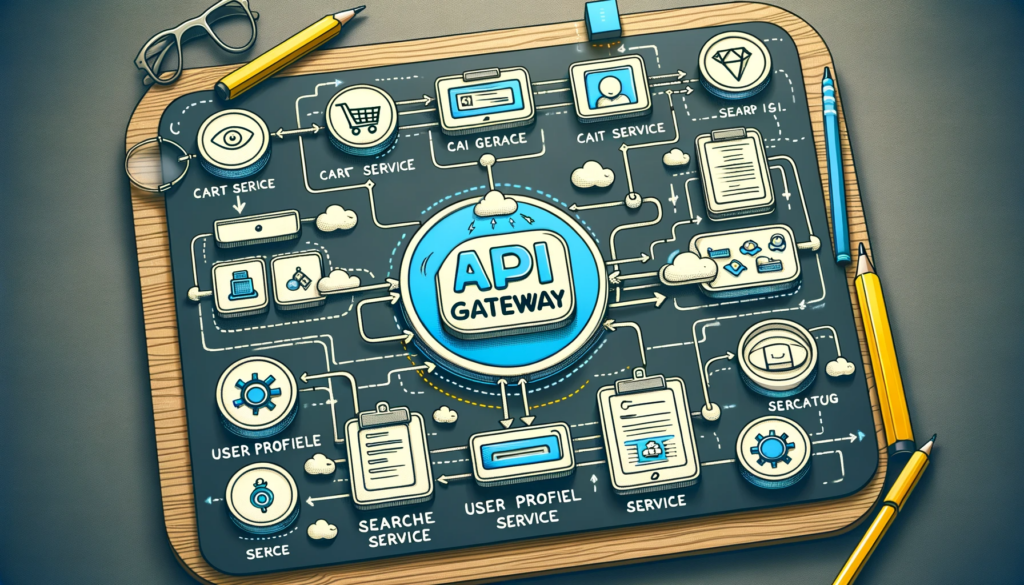
Imagine you’re in a bustling city center, a place alive with activity. In every direction, people are communicating, buying, selling, and exchanging ideas. It’s vibrant and exciting, but without something to organize the chaos, it would quickly become overwhelming. This is where an API Gateway steps in, not as a towering overseer, but as a friendly guide, making sure everyone gets where they’re going quickly and safely.
What’s an API Gateway, Anyway?
Think of an API Gateway like the concierge at a grand hotel. Guests come from all over the world, speaking different languages and seeking various services. The concierge understands each request and directs guests to the exact services they need, from the restaurant to the gym, to the conference rooms.
In the digital world, our applications and devices are the guests, and the API Gateway is the concierge. It’s the front door to the hotel of microservices, ensuring that each request from your phone or computer is directed to the right service at lightning speed.
Why Do We Need API Gateways?
As our digital needs have evolved, so have the systems that meet them. We’ve moved from monolithic architectures to microservices, smaller, more specialized programs that work together to create the applications we use every day. But with so many microservices involved, we needed a way to streamline communication. Enter the API Gateway, providing a single point of entry that routes each request to the right service.
The Benefits of a Good API Gateway
The best API Gateways do more than just direct traffic; they enhance our experiences. They offer:
- Security: Like a bouncer at a club, they check IDs at the door, ensuring only the right people get in.
- Performance: They’re like the traffic lights on the internet highway, ensuring data flows smoothly and quickly, without jams.
- Simplicity: For developers, they simplify the process of connecting services, much like a translator makes it easier to understand a foreign language.
API Gateways in the Cloud
Today, the big players in the cloud—Amazon, Microsoft, and Google—each offer their own API Gateways, tailored to work seamlessly with their other services. They’re like the top-tier concierges in the world’s most exclusive hotels, offering bespoke services that cater to their guests’ every need.
In the clouds where digital titans play, API Gateways have taken on distinct personas:
- Amazon API Gateway: A versatile tool in AWS, it provides a robust, scalable platform to create, publish, maintain, and secure APIs. With AWS, you can manage traffic, control access, monitor operations, and ensure consistent application responses with ease.
- Azure API Management: Azure’s offering is a composite solution that not only routes traffic but also provides insights with analytics, protects with security policies, and aids in creating a developer-friendly ecosystem with developer portals.
- Google Cloud Endpoints: Google’s entrant facilitates the deployment and management of APIs on Google Cloud, offering tools to scale with your traffic and to integrate seamlessly with Google’s own services.
What About the Technical Stuff?
While it’s true that API Gateways operate at the technical layer 7 of the OSI model, dealing with the application layer where the content of the communication is king, you don’t need to worry about that. Just know that they’re built to understand the language of the internet and translate it into action.
A Digital Conductor
Just like a conductor standing at the helm of an orchestra, baton in hand, ready to guide a multitude of instruments through a complex musical piece, the API Gateway orchestrates a cacophony of services to deliver a seamless digital experience. It’s the unseen maestro, ensuring that each microservice plays its part at the precise moment, harmonizing the backend functionality that powers the apps and websites we use every day.
In the digital concert hall, when you click ‘buy’ on an online store, it’s the API Gateway that conducts the ‘cart service’ to update with your new items, signals the ‘user profile service’ to retrieve your saved shipping address, and cues the ‘payment service’ to process your transaction. It does all this in the blink of an eye, a performance so flawless that we, the audience, remain blissfully unaware of the complexity behind the curtain.
The API Gateway’s baton moves with grace, directing the ‘search service’ to fetch real-time results as you type in a query, integrating with the ‘inventory service’ to check for stock, even as it leads the ‘recommendation engine’ to suggest items tailored just for you. It’s a symphony of interactions that feels instantaneous, a testament to the conductor’s skill at synchronizing a myriad of backend instruments.
But the impact of the API Gateway extends beyond mere convenience. It’s about reliability and trust in the digital spaces we inhabit. As we navigate websites, stream videos, or engage with social media, the API Gateway ensures that our data is routed securely, our privacy is protected, and the services we rely on are available around the clock. It’s the guardian of uptime, the protector of performance, and the enforcer of security protocols.
So, as you enjoy the intuitive interfaces of your favorite online platforms, remember the silent maestro working tirelessly behind the scenes. The API Gateway doesn’t seek applause or recognition. Instead, it remains content in knowing that with every successful request, with every page loaded without a hitch, with every smooth transaction, it has played its role in making your digital experiences richer, more secure, and effortlessly reliable—one request at a time.
When we marvel at how technology has simplified our lives, let’s take a moment to appreciate these digital conductors, the API Gateways, for they are the unsung heroes in the grand performance of the internet, enabling the symphony of services that resonate through our connected world.

